Broad beans, also called fava beans, are a cool-season crop. The broad bean is a bushy, hardy annual that can grow from 3 to 4½ feet (.9-1.3m) tall. The broad bean has square stems with leaves divided into leaflets.
Plant broad beans, also called fava beans, directly in the garden 4 to 7 weeks before the last frost in spring. Sow broad beans as soon as the soil can be worked for harvest before the weather warms.
Related articles:
Broad beans are a cool-season crop that grows best in temperatures ranging from 60° to 65°F (15-18°C) but fava beans will grow in temperatures as low as 40°F (4.4°C) and as warm as 75°F (24°C).
Broad beans can withstand light frost. For an extra-early start, sow fava beans 10 to 12 weeks before the last frost and have them ready to set out as soon as the soil can be worked. Young plants in the garden are best protected against heavy frost with row covers or plastic tunnels.
Broad beans require 80 to 100 days to reach harvest. In mild-winter regions sow broad beans in early autumn for winter harvest for a spring harvest.
Broad beans are not recommended as a summer crop where summers are dry and hot.
Broad beans will grow in most soils as long the soil is well-drained. Broad beans prefer a soil pH between 6.0 and 7.5.
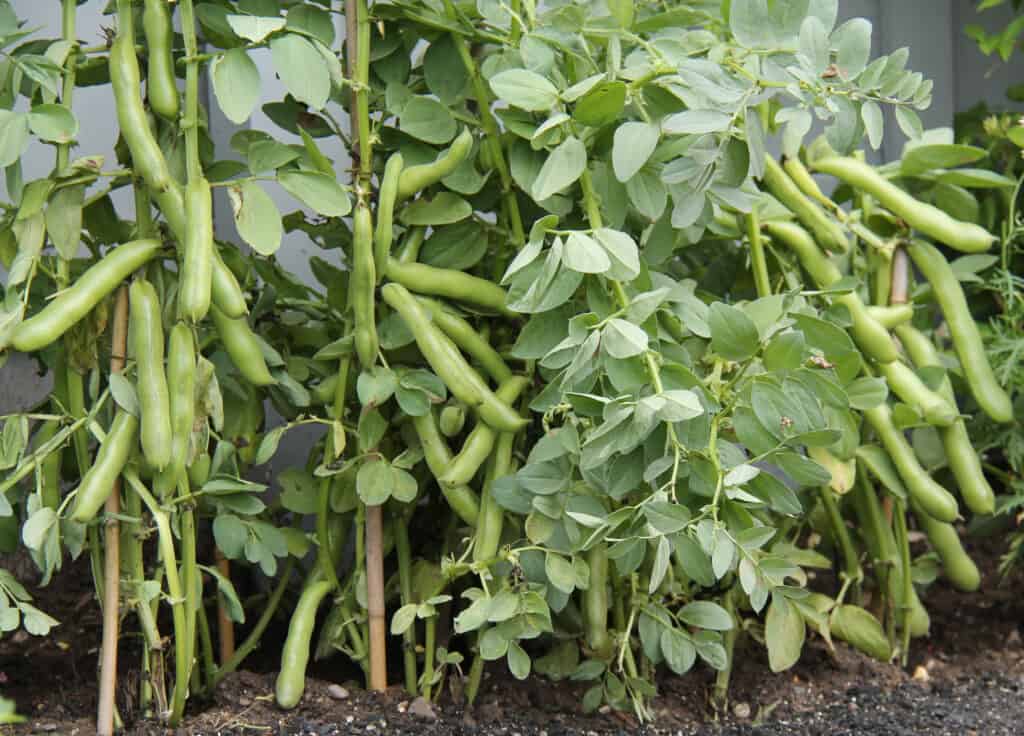
Harvest broad beans by picking the lowest pods on the plant first and working up the plant. Broad beans can be used young as snap beans or let beans develop in the pods.
Broad bean pods are 6 to 8 inches (15-20cm) long and contain 4 to 6 flat, oval seeds that can be white, yellow, green, or pinkish-red. The broad bean has white flowers that are splotched with brown. The broad bean is not a true bean; it is related to vetch, another legume.
Broad bean, fava bean planting details
- Sowing depth: 1 inch (2.5cm)
- Space between plant after thinning: 8 inches (20cm)
- Days to sprout: 10
- Days to harvest: 80-100
- Storage period: 1-2 weeks fresh or several months dried
- Seeds per 100-row feet: ½ pound
- Yield per 100-row feet: 60 pounds (29 kg)
- Suggested varieties: Aguadulce, Broad Windsor, Con Amore, Loretta, Sweet Lorraine, Windsor Long Pod
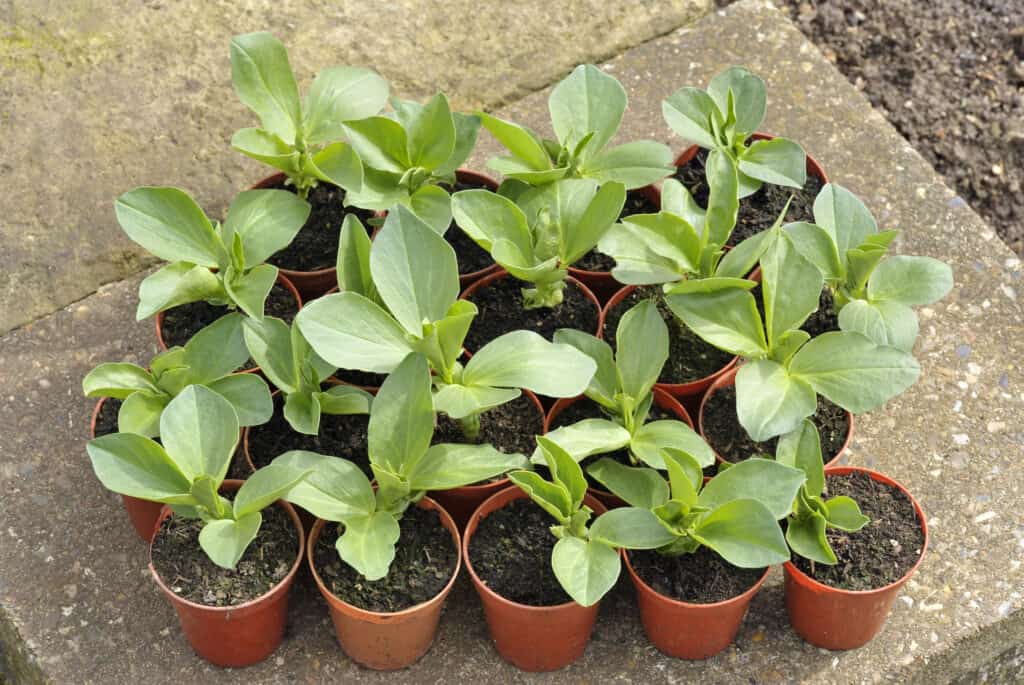
Broad beans–fava beans quick growing tips
- Sow broad beans in spring as soon as the soil can be worked for harvest before the weather warms.
- Broad beans grow best in temperatures ranging from 60° to 65°F (15-18°C) but fava beans will grow in temperatures as low as 40°F (4.4°C) and as warm as 75°F (24°C).
- Broad beans require 80 to 100 days to reach harvest. In mild-winter regions sow broad beans in early autumn for winter harvest.
- Yield: Plant 4 to 8 broad beans per household member.
Where to plant broad beans–fava beans
- Grow broad beans in full sun.
- Plant broad beans in loose, well-drained soil rich in organic matter. Add aged compost to planting beds before planting.
- Broad beans prefer a soil pH of 6.0 to 6.8.
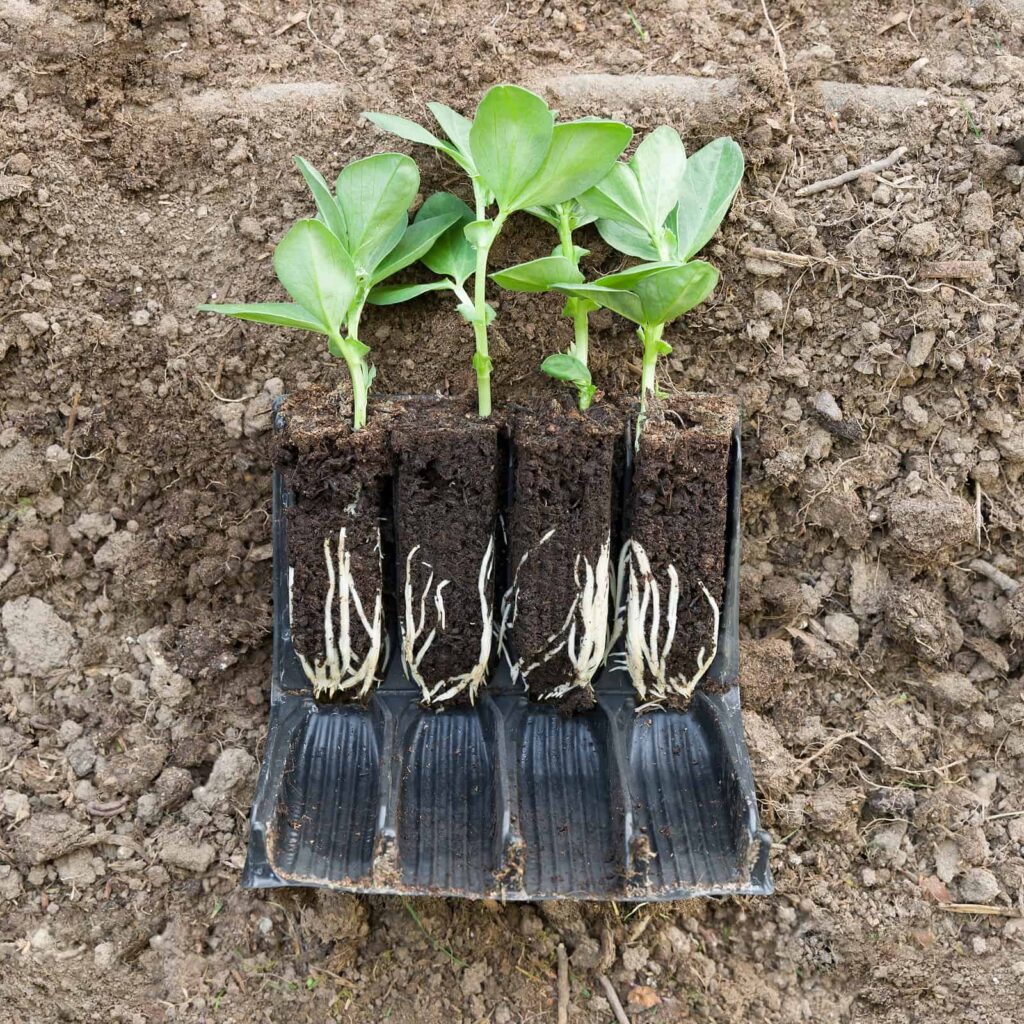
Broad beans planting time
- Broad beans grow best in cool weather where air temperatures are below 70°F (21°C).
- Broad beans, unlike snap beans, will not set pods in warm weather.
- Sow broad beans in early spring as soon as the soil can be worked.
- Broad beans will grow in temperatures as low as 40°F (4.4°C).
- Broad beans require 80 to 100 days to reach harvest.
- In mild-winter regions sow broad beans in early autumn for winter or spring harvest. They will not produce in the summer’s heat.
- In cold regions, grow broad beans instead of lima beans, which require a warmer and long growing season.
Broad bean, fava bean planting dates
(These dates are for the Northern Hemisphere)
| Average date of the last frost | Planting dates |
| Jan. 30 | Jan. 1-Feb. 15 |
| Feb. 8 | Jan. 10-Feb. 20 |
| Feb. 18 | Jan. 20-Mar. 1 |
| Feb. 28 | Feb. 1-Mar. 15 |
| Mar. 10 | Feb. 10-Mar. 30 |
| Mar. 20 | Feb. 20-Apr. 1 |
| Mar. 30 | Mar. 1-Apr. 10 |
| Apr. 10 | Mar. 10-Apr. 20 |
| Apr. 20 | Mar. 20-Apr. 1 |
| Apr. 30 | Mar. 30-May 10 |
| May 10 | Apr. 10-May 15 |
| May 20 | Apr. 20-May 30 |
| May 30 | Apr. 30-June 10 |
| June 10 | May. 10-June 15 |
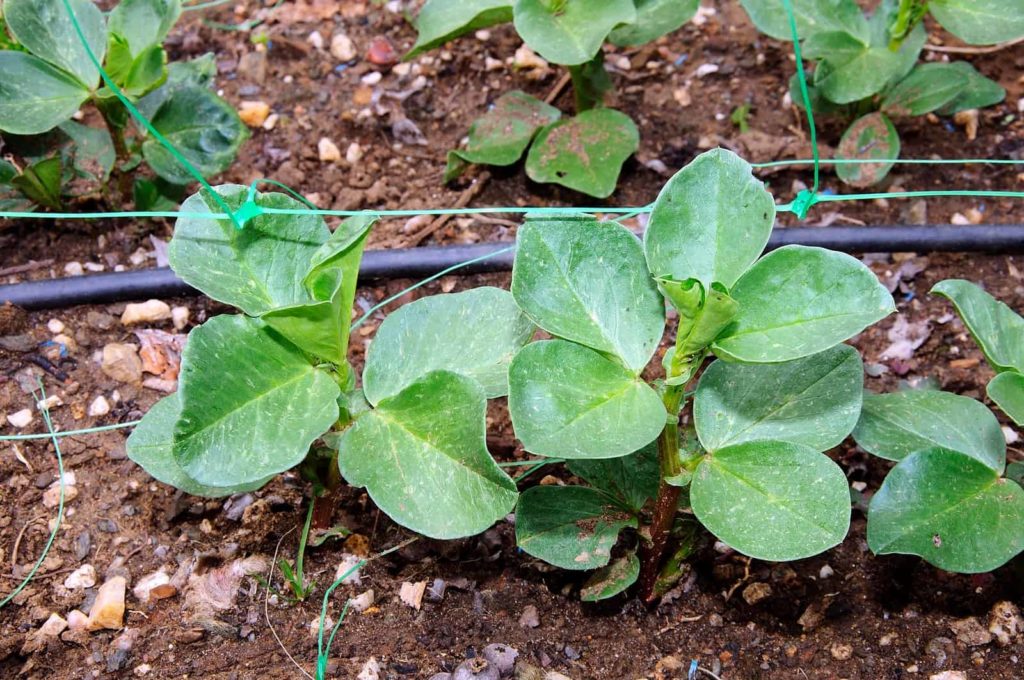
Planting and spacing broad beans
- Sow broad bean seeds 1 inch deep and 4 to 5 inches (10-12cm) apart.
- Space rows 18 to 30 inches (45-76cm) apart.
- Thin seedlings to stand 8 to 10 inches (20-25cm) apart. I
- n short-season regions, start broad beans indoors in peat pots and set them in the garden shortly after the last frost in spring.
Broad beans companion plants
- Grow brad beans with potatoes, cucumbers, corn, strawberries, celery, and summer savory.
- Do not plant broad beans with onions or garlic.
Container growing broad beans
- Beans can be grown in containers; use a 5-gallon container. A good crop will take more space than most containers can provide.
Watering and feeding broad beans
- Water broad beans just before the soil dries out, but do not over-water them.
- Keep soil moist during flowering and pod formation.
- Plant beans in well-drained soil.
- Broad beans do not require feeding apart from planting in fertile, composted soil. Beans set up a mutual exchange with soil microorganisms called nitrogen-fixing bacteria, which help them produce usable nitrogen.
Broad beans care
- Keep planting beds weed-free; cultivate shallowly to avoid disturbing roots.
Broad beans pests
- Broad beans can be attacked by aphids, bean beetles, flea beetles, leafhoppers, and mites.
- Spray aphids away with a blast from the hose.
- Bean beetles and flea beetles can be controlled with sticky traps.
- Exclude leafhoppers with horticultural fleece or spray with insecticidal soap. and mites can be controlled.
- Spray mites with insecticidal soap.
- Small white and yellow moths are adult cabbage worms that shelter in beans. They will not harm beans.
Broad beans diseases
- Beans are susceptible to blight, mosaic, and anthracnose.
- Cut down the incidence of disease by planting disease-resistant varieties.
- Keep the garden clean. Avoid handling the plants when they are wet.
- Remove and destroy infected plants so they can not spread the disease to healthy plants.
- Soil-borne diseases can be reduced by changing the location of bean crops each year.
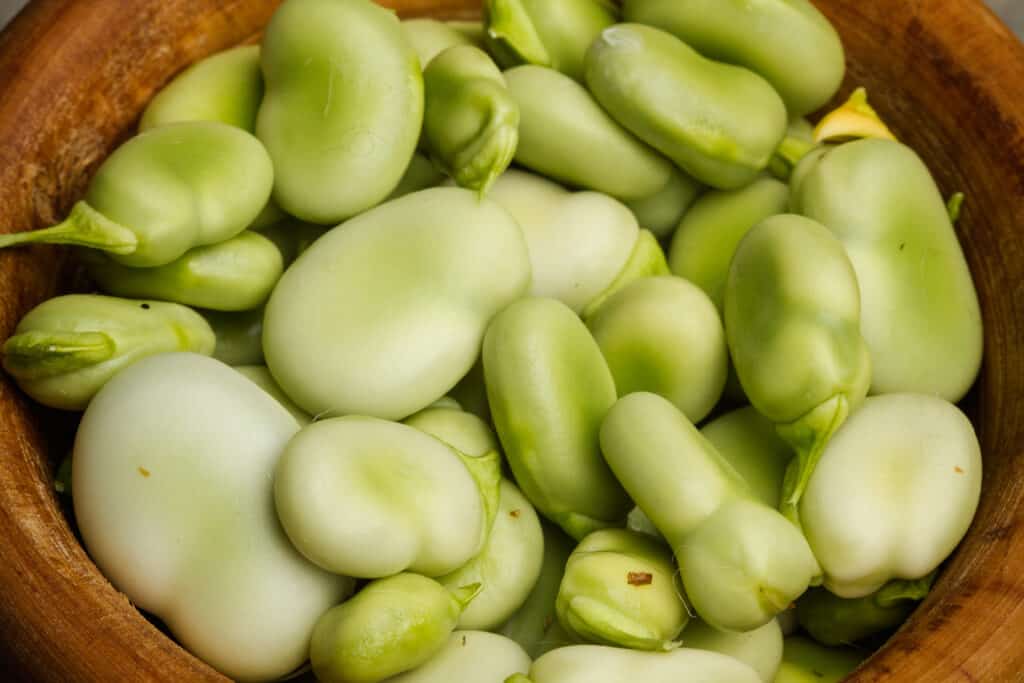
Harvesting broad beans
- Pick broad beans for fresh use like you would snap beans–when the seeds are about the size of a pea.
- Pick broad beans for drying when they mature and begin to yellow, usually about 85 days after planting.
How to dry broad beans
- For dry beans, let the pods mature and turn yellow.
- Pick the pods before they darken or turn black (a sign of mold); this can happen quickly in humid or wet regions. If you allow the pods to turn black they will require additional time to dry.
- Dry fava beans on a screen or cookie sheet in a warm, sheltered spot with good air circulation; do not dry beans outdoors if it is humid.
- Beans can also be dried in a food dehydrator set on low heat.
- The skin of the fava bean will wrinkle when it is dry.
Storing and preserving broad beans
- Unshelled broad beans will keep in the refrigerator for up to 1 week.
- Broad beans can be frozen, canned, or dried.
- Dried-shelled broad beans can be stored in a cool dry place for 10 to 12 months.
Broad beans varieties to brow
Few named varieties may be available; grow the variety available in your area.
- Short-season varieties (80 days): ‘Express’, ‘Loretta’, ‘The Sutton’.
- Longer-maturing varieties (90 days or more): ‘Aprovecho Select’, ‘Aquadulce’, ‘Aquadulce Claudia’, ‘Imperial Green Longpod’, ‘Jumbo’, ‘Masterpiece’.
About broad beans
- Common name. Bean, broad bean, fava bean, Windsor bean, Scotch bean, horse bean
- Botanical name. Vicia faba
- Origin. Central Asia
Related articles:
How to Plant and Grow Snap Beans
How to Harvest and Store Snap Beans
Bean Growing Problems: Troubleshooting
Five Ways to Quick Cook and Serve Snap Beans
How to Can Green Snap Beans for Beginners
Cooking and Serving Yard-Long Beans
How to Grow Plant, Grow, and Harvest Chickpeas and Garbanzo Beans
How to Cook and Serve Chickpeas
How to Plant and Grow Lima Beans
How to Plant, Grow, and Harvest Broad Beans and Fava Beans
Five Ways to Cook and Serve Fava Beans
All About Dried Beans – Growing and Cooking
Container Growing Beans – Plant, Grow, and Harvest Tips
More how to grow articles:
Learn how to plant, grow, and harvest your favorite vegetables. Click below for all you need to know.
- Artichoke
- Arugula
- Asparagus
- Beans, Snap
- Beets
- Broad Beans
- Broccoli
- Brussels Sprouts
- Cabbage
- Cantaloupe — Melons
- Cardoon
- Carrots
- Cauliflower
- Celeriac
- Celery
- Chard
- Chayote Squash
- Chickpeas
- Chicory
- Chinese Cabbage
- Collards
- Corn Salad
- Corn, Sweet
- Cresses
- Cucumbers
- Eggplant
- Endive and Escarole
- Fava Beans
- Florence Fennel
- Garbanzo Beans
- Garlic
- Horseradish
- Jerusalem Artichoke
- Kale
- Kohlrabi
- Leeks
- Lettuce
- Lima Beans
- Melons
- Mizuna
- Mustard Greens
- New Zealand Spinach
- Okra
- Onions
- Parsnips
- Peanuts
- Peas
- Peppers
- Potatoes
- Pumpkins
- Radicchio
- Radishes
- Rhubarb
- Rutabaga
- Salsify
- Shallots
- Sorrel
- Southern Peas
- Soybeans
- Spinach
- Squash, Summer
- Squash, Winter
- Sunchokes
- Sweet Potato
- Swiss Chard
- Taro
- Tomatillo
- Tomatoes
- Turnips
- Watermelon
- Zucchini
Garden Planning Books at Amazon:
- Vegetable Garden Almanac & Planner
- Kitchen Garden Grower’s Guide Vegetable Encyclopedia
- Vegetable Garden Grower’s Guide
- Tomato Grower’s Answer Book



